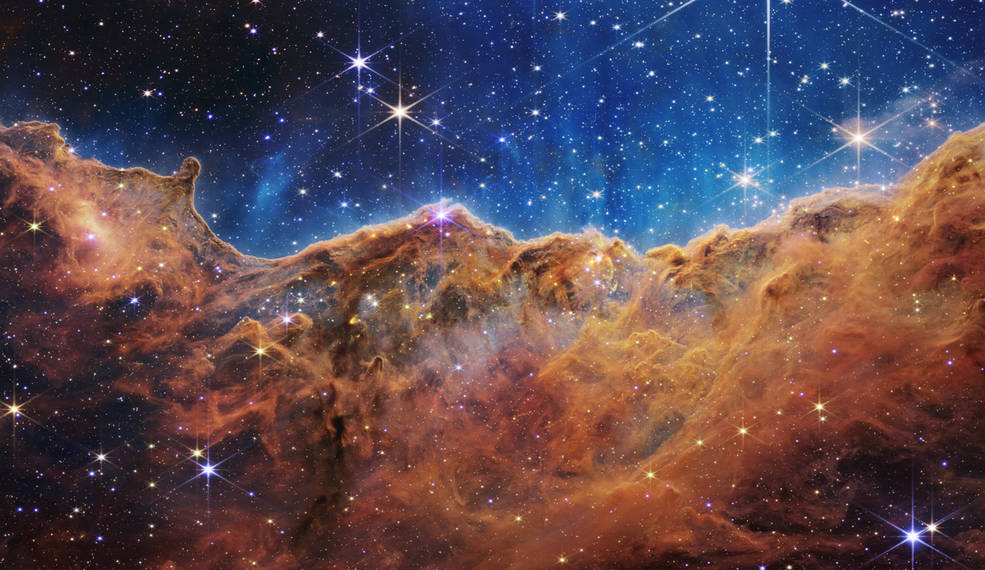Working on the longest time scale, 13 billion years ago and beyond, the James Webb Space Telescope is set to explore the roles of dark matter and giant black holes in creating stars and whole galaxies.
Dark matter is six times more abundant than the ordinary matter of the universe with which we’re familiar and is thought to play a major gravitational role in shaping vast collections of gas and dust into what become stars and galaxies.
And dark energy is the major force driving the continuing expansion of the universe.
Unfortunately, both remain stubborn mysteries, especially dark matter, for which the search continues this year with the updated Hadron Collider in Switzerland.
What about time scales of hundreds of millions of years during which movement of the Earth’s tectonic plates driven by vertical currents in the planet’s mantle drive whole continents together or apart to form new land masses, mountain ranges and oceans, in the process recycling into the Earth’s interior undercutting tectonic plates to erase long familiar land and sea marks.
Land bridges between Africa and South America during the last period when the two continents abutted one another explain the common evolutionary roots for “old” and “new” world monkeys and thousands of other species now found in both continents whose evolutionary paths took different routes once their ancestral species were separated.
Then there is the shorter time scale of the 100,000-year cycle in which the Earth’s climate shifts between glacial and interglacial periods.
In fully developed glacial periods, much of the northern and southern hemispheres became covered by vast, thick and heavy ice sheets, which depress and gouge the Earth’s surface and lower ocean levels. In the process, they create land bridges.
On the other hand, interglacial periods are associated with rising sea levels and the warming, melting and retreat of those vast ice sheets. Favourable climate changes were associated with to and fro migrations of small groups of archaic and later modern humans between Africa and Eurasia, and later migrations into the Americas.
Glacial and interglacial periods hold true for tropical regions, too, such as the Andes mountains, where glaciers extended and retreated with the same cyclic rhythm.
Evidence of this was recently found in core samples of successive sedimentary deposits in Lake Junin in the Andes. Over 680,000 years, the timing and nature of those deposits fit precisely with the glacial-interglacial cycles observed elsewhere on Earth.
The cyclical glacial and interglacial periods reflect cyclical changes in the orbit of the Earth around the sun, which in turn is the result of cyclical changes in the gravitational effects of other planets in the solar system on Earth. That major climate changes on Earth reflect cyclical changes in the gravitational effects of other planets is a mindboggling thought.
The earliest traces of life on Earth date back 4 billion years, when life was confined to single cells. However, even the simplest single cells contain RNA or DNA, hundreds, if not several thousand genes, and many thousands of different proteins, to say nothing of the complex nature of the cell membrane.
Life must have begun much simpler, but with what? RNA, amino acids and simple proteins? Or as Nick Lane recently suggested in his book “Transformer,” with simple versions of the Krebs cycle which normally oxidizes sugars and fats into energy and carbon dioxide.
Lane and other scientists suggest that, run backward, the Krebs cycle could eventually create, through trial and error, all the building blocks of life, including RNA. It is a transformative hypothesis for explaining the beginnings of life on Earth and perhaps, many places in the universe.
Those are a few of the time scales to consider in science’s creation story, one of which I’ve left out. That we’re even aware of such origin stories and marvel as more pieces of the puzzle are solved, is testament to one species – homo sapiens.
One recent product of the human brain was to create a tiny motor, less than one-thousandth of the thickness of the paper this is printed on. Made of DNA, the motor self-assembles (origami) into a pedestal, platform and a unidirectional rotor powered by a tiny externally applied alternating current.
That was a major technological achievement for humans. But what about living cells? They contain thousands of biological motors for transporting, assembling and disassembling molecules. We’re just beginning to catch up.
Nature writ large and tiny is amazing, yet we are unaware of most of it.
Dr. William Brown is a professor of neurology at McMaster University and co-founder of the Infohealth series at the Niagara-on-the-Lake Public Library.









